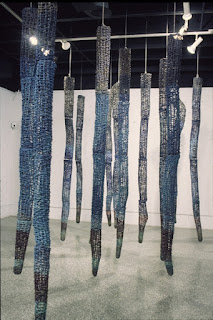Below are some examples.
Because I was knitting I decided that I would go to the workshop on textiles. I thought I might use some of the felting methods in the way I was working. This workshop was very exciting and full of colour, the sky was the limit, as far as textiles were concerned, they could be used in studio practises crossing all of the disciplines I was interested in. I learnt that felting has wonderful potential and that almost anything can be felted. We looked at techniques and materials that built textures, that provided structural elements, that draped, fused and pleated. We learnt about a technique called shaborie and how when employed the fabric took on the shape of the object that was used in the process. Around this time I went to the 'Twisted Threads' exhibition in the RDS in Dublin and saw the work of artists using felt, stitches and knitting. Among them were the following
 |
| 'Scavengers' Caroline Schofield |
 |
| Sheila Jordan |
 |
| 'Leaving Dublin Bay', Tara Ni Nuallainn |
In the next textile workshop we learnt the art of felting, and below are some of the images of the process involved.
Somewhere along the workshop journey I ventured in to ceramics and I had a ball, I loved the tactile nature of the clay. Again I was interested to see how I could knit using clay. Surprise, surprise it worked and I have a swatch or perhaps I should say clay piece that survived firing and came out without breaking or cracking in the firing process.
Once I had this piece out of my system, I got cracking and experimented with the clay looking at other stitch formations. I started to make little structures that seemed to have a life of their own.
Contextually I was looking at the ceramic sculptures of Laurie Spencer. These huge dome structures built and fired on site reminded me of the little ones I had made. Connections! I see them everywhere.
 |
| 'Ceramic Domes' by Laurie Spencer |
The other workshops I attended were Print and Life drawing, but I 'll blogg about these at another time as its getting late and my fingers are tripping over themselves. I'm sure its natures way of telling me I need sleep.













No comments:
Post a Comment